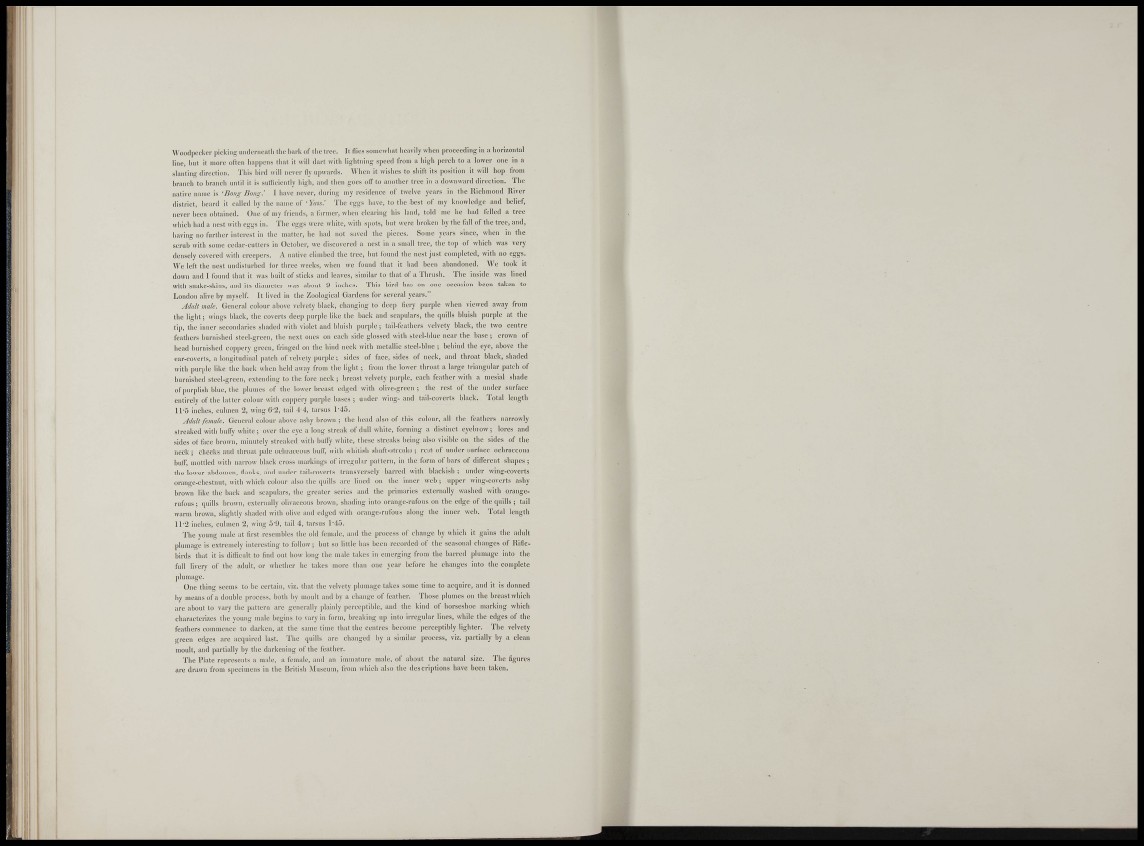
\Voo(l|reclici- ])li'l<ii)i; iimlernoatli the bark of llie tree. It ilies somcwluit heiivily when proceeding in a horizontal
line, hut it more often luippsns that it will dart with lightning speed from a high jierch to a lower one in a
slanting direetion. This hird will never fly n|)wards. When it wishes to shift its position it will hop from
hraneh to hraiieli until it is snllieiently high, and then goes oil'to another tree in a downward direction. The
native uiinie is 'JSong Bong.' I have never, during my residence of twelve years in the Richmond River
district, heard it called hy the name of ' 5'kw.' The eggs have, to the best of my knowledge and belief,
never been obtained. One of my friends, a farmer, when clearing his land, told me he had felled a tree
which had a nest with eggs in. The eggs were white, with spots, hut were broken by the fall of the tree, aud,
having no further interest iu the matter, be had not saved the pieces. Some years since, when in the
scrub with sonic cedar-cutters in October, we discovered a nest in a small tree, the top of which was very
densely covered with creepers. A native climbed the tree, but found the nest just completed, with no eggs.
We left the nest undisturbed tor three weeks, when we found that it had been abandoned. We took it
down and I found that it was built of sticks and leaves, similar to that of a Thrush. The inside was lined
with suake-skins, mul its diameter was about 9 inches. This bird has on one occasion been taken to
London alive by myself. It lived in the Zoological Gardens for several years."
Adult male. General colour above velvety black, changing to deci) fiery purjjle when viewed away from
the light; wings blaek, the coverts deep purple like the back and scapulars, the quills bluish purple at the
tip, the inner secondaries shaded with violet and bluish purple; tail-feathers velvety black, the two centre
feathers burnished steel-green, the next ones on each sitie glossed with steel-blue near the base ; crown of
head burnished coppery green, fringed on the hind neck with metallic steel-blue ; behind the eye, above the
ear-coverts, a longitudinal patch of velvety jjurple; sides of tace, sides of neck, and throat black, shaded
with purple like the back n hen held away from the light ; from the lower throat a large triangular patch of
burnished steel-green, extending to the fore neck ; breast velvety purple, each feather with a mesial sluide
of purplish blue, the jilumes of the lower breast edged with olive-green ; the rest of the under surface
entirely of the latter colour with coppery purple bases ; uiidcr wing- and tail-coverts black. Total length
11-5 inches, culmen 2, wing 0-2, tail 4 4, tarsus 1'45.
Adult female. General colour above ashy brown ; the head also of this colour, all the feathers narrowly
streaked with bully white; over the eye a long streak of dull white, forming a distinct eyebrow; lores mid
sides of fitcc brown, minutely streaked with bully white, these streaks being- also visible on the sides of the
neck ; eliccks aud throat ]iale ochraccous bulf, with whitish shaft-streaks ; rest of under surface ochraceous
buir, mottled with narrow black cross markings of irregular pattern, in the form of bars of dilferent shapes ;
the lower abdoLnen, llaid^s, and under tail-coverts transversely barred with blackish ; under wing-eoverts
orange-ehcstnut, with which colour also the (piills are lined on the inner web ; ujiper wing-eovei'ts ashy
brown like the back and scajndars, the greater series and the primaries externally washed with orangerufous
; quills brown, externally olivaceous brown, shading into orange-rufous on the edge of the quills ; tail
warLn brown, slightly shaded with olive and edged with orange-rufous along the inner web. Total length
11-2 iLiches, culmen 2, wing o'O, tail 4, tarsus 1-45.
The young male at first resembles the old female, and the process of change by nhicb it gains the adult
plumage is extremely interesting to follow; but so little has been recorded of the seasonal changes of Ritlebirds
that it is difficult to find out how long the male takes in emerging from the barred plumage into the
full livery of the adult, or whether be takes more than one year before he changes into the complete
plumage.
One thing seems to be certain, viz. that the velvety plumage takes some time to acquire, and it is donned
by means of a double process, both by moult and by a change of feather. Those plumes on the breast which
are about to vary the pattern are generally plainly perceptible, and the kind of horseshoe marking which
characterizes the young male begins to vary in form, breaking up into irregidar lines, while the edges of the
feathers commence to darken, at the same time that the centres become ¡¡erccptibly lighter. The velvety
green edges are acquired last. The (juills are changed by a similar process, viz. ])artially by a clean
moult, and partially by the darkening of the feather.
The I'late represents a male, a female, and an immature male, of about the natural size. The figures
are drawn from siiecimens in the British Museum, from which also the descriptions have been taken.